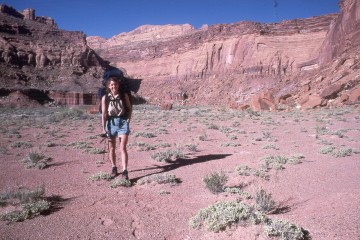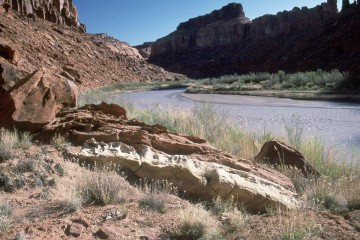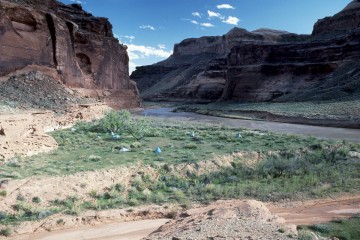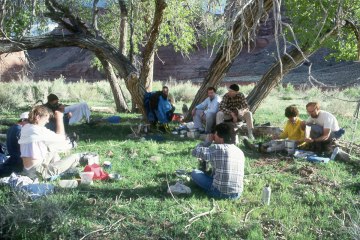The Dirty Devil: Living Up to Its Name
Headin' up river
Monday, April 25 A few clouds this morning. Our first order of business was to say goodbye to John. He had joined us, and now had to head on back, dealing with the Twin Alcoves and the Great Alcove on his own. He talked quite a lot about the advantages of tackling these headed uphill, which is inherently easier than going downhill. We all admonished him to pay attention to where one has to make the final pitch up to the canyon rim, because we all knew that on slickrock, without cairns, or other prominent features, it is easy to mis-judge one's position. And mis-judge he did. I could summarize, but let's hear the story in Professor John's own words:
|
I remember the day well–Monday, April 25, 1988. I left you guys on the Dirty Devil River about 8:30 that morning. Ordinarily I wouldn't hike alone in an isolated area that was unknown to me, but I had to get back for Wednesday classes at UNLV. I made good time up the Twin Alcove Gorge and onto the Kayenta Plateau and then around the edge of the Great Alcove. After a quick lunch, I had no trouble going up the short ascent onto the Navajo Bench (though I did have to line my pack a few feet). But as I was angling up the slope toward the rim along what I thought was an appropriate grade, the pitch quickly became steeper, the "route" narrower, and I was holding on for balance to a wall that was now on my right. Beneath me was a steep, nearly sheer slope of 30-40 feet to a level bench that was about 10 feet wide. Below the bench it dropped off all the way to the bottom of the canyon. Rather than retreating, I foolishly took a couple of steps along the face and suddenly found myself–I'm still not sure how-- with nothing but toe holds and most of my weight on my left foot. I tried to shift my weight and turn around. There I was, clinging to the wall face-first, with almost no purchase for my feet or my hands. My fingers were literally digging into the wall, with the weight of my pack hanging out over the edge. I knew I was going down, and after about five seconds I did--forearms, fingers, and thighs getting banged, gouged, and sandpapered. Fortunately, the moment I lost my balance my shoulder straps slipped away, my Kelty came unbuckled, and it preceded me down the face. When I banged to a stop at the bottom, I was atop my sleeping bag which was attached to the bottom of my pack frame. The pack itself was wedged between the face of the slope and the point of a sharp upward pointing rock. I don't even want to think what would have happened if I hadn't landed on my pack. For a moment or two I was stunned., then gingerly moved my limbs to make sure nothing was broken. If I had broken a leg there, I don't know how long I would have been on that ledge. But except for a lot of painful abrasions and a fair amount of spilled blood, I was fine. The bench continued around the face for a short distance and then blended into an easily traversable slope. I got back to my car at Burr Point around 2:40, left a message on your van, and then drove to Hanksville, where my appearance grossed out some locals in a café. After cleaning up, I had a few beers and the greasiest, best hamburger of my life. |
 I was looking forward to finally hiking in the river canyon. The Dirty Devil River has a reputation, and in retrospect, it is well deserved. I would quickly learn that it is a difficult river to hike. Below is part of my response to a ranger which had provided us with a considerable amount of useful information, made a couple of weeks after the completion of the trip, edited only for clarification, and I think they capture the essence of the challenge.
I was looking forward to finally hiking in the river canyon. The Dirty Devil River has a reputation, and in retrospect, it is well deserved. I would quickly learn that it is a difficult river to hike. Below is part of my response to a ranger which had provided us with a considerable amount of useful information, made a couple of weeks after the completion of the trip, edited only for clarification, and I think they capture the essence of the challenge.
Monday was our first taste of crossing the river with heavy packs. We found this to be more challenging than we had anticipated, given the relatively low water level. I have since received data from the USGS, indicating that the 4 am flows in the river were never greater than 200 cfs between Sunday and the following Saturday. The peak flow during our visit was 246 cfs, at 4 pm on Monday. We were impressed with how tricky the river is to read and cross. Several of us had tackled the lower Escalante during one of its high flow times (early May, 1980), and thought the Dirty Devil was much more difficult. Two things make it that way. First, the consistency of the bottom is highly variable. One can go from hard packed sand to mid-calf deep mud in a matter of a few feet. Secondly, while it is possible to make some general conclusions about the depth of the water in various spots, there is considerable variation in the magnitude of the depth over a relatively short distance. Several times when 2 or 3 individuals would be hiking together, one might go up to his knees, while another would go up to mid-chest. Exciting. I would suggest that you advise individuals to check with the river forecast center. Between 100 and 200 cfs, you will find it "interesting" and somewhat challenging. Between 200 and 300 cfs, you will have to pick your crossing spots with considerable care. Between 300 and 400 cfs, picking a crossing will be difficult, and the crossing itself will be probably more exciting than most backpackers would like. Above 400 cfs, I would imagine that it will be difficult to stand up against the water flow. Also, there appear to be a minimum of 31 river crossings between the flats below Twin Alcoves and Angel Cove Spring.
 The route out of Twin Alcoves Camp is pretty straightforward: there is an old uranium mining road that goes up the canyon, and while it is not pretty, it gets you there. Since the canyon at this point had a pretty broad floor, there did not seem to be a lot of benefit in going up one side or another. It was pretty much just follow the path of least resistance. I don't want to downplay the beauty of this place: the canyon walls are high, well over a thousand feet in the lower part of the canyon. It is just that because they are so far apart, one loses some of the effect you might get if you were in, say, the lower Escalante. It was a fair piece of hiking to get to our destination for the night, Larry Canyon. The going was easy, until I had to make my first river crossing with full pack. I recall that it was not terrible, you just had to pay attention, and feel your way with - in my case - a tripod. I did not have my camera covered in a bag, as it would get really hot inside it when the camera was in the full sun, as it was all morning. In retrospect, I was damn lucky I did not have to buy a new camera at the end of the trip.
The route out of Twin Alcoves Camp is pretty straightforward: there is an old uranium mining road that goes up the canyon, and while it is not pretty, it gets you there. Since the canyon at this point had a pretty broad floor, there did not seem to be a lot of benefit in going up one side or another. It was pretty much just follow the path of least resistance. I don't want to downplay the beauty of this place: the canyon walls are high, well over a thousand feet in the lower part of the canyon. It is just that because they are so far apart, one loses some of the effect you might get if you were in, say, the lower Escalante. It was a fair piece of hiking to get to our destination for the night, Larry Canyon. The going was easy, until I had to make my first river crossing with full pack. I recall that it was not terrible, you just had to pay attention, and feel your way with - in my case - a tripod. I did not have my camera covered in a bag, as it would get really hot inside it when the camera was in the full sun, as it was all morning. In retrospect, I was damn lucky I did not have to buy a new camera at the end of the trip.
 Russ and I, along with Sam and Kevin and Will ate lunch at the mouth of a unnamed sidecanyon. As is often the case, we were spread out over quite a distance, and it was sorta good to get together and compare notes. While we had made only one river crossing before lunch, a look at the map suggested we would have several after lunch. The response from everyone was uniformly: Tricky, and you have to pay attention, but doable. I guess you could not ask for more. I kept wondering what it would be like in late May, when the snow melt would really go like gangbusters. Not pleasant, for sure. We pulled up onto a bench at the mouth of Larry Canyon after about 6 hours of hiking up from Twin Alcoves, including lunch and minor poking around. We were treated to a great campsite: a multi-acre grassy bench, that was graced by a couple of scarce cottonwood trees. They did seem to be a rarity out here. It was not like we needed a lot of shade, but the trees add a civilized touch to the whole experience.
Russ and I, along with Sam and Kevin and Will ate lunch at the mouth of a unnamed sidecanyon. As is often the case, we were spread out over quite a distance, and it was sorta good to get together and compare notes. While we had made only one river crossing before lunch, a look at the map suggested we would have several after lunch. The response from everyone was uniformly: Tricky, and you have to pay attention, but doable. I guess you could not ask for more. I kept wondering what it would be like in late May, when the snow melt would really go like gangbusters. Not pleasant, for sure. We pulled up onto a bench at the mouth of Larry Canyon after about 6 hours of hiking up from Twin Alcoves, including lunch and minor poking around. We were treated to a great campsite: a multi-acre grassy bench, that was graced by a couple of scarce cottonwood trees. They did seem to be a rarity out here. It was not like we needed a lot of shade, but the trees add a civilized touch to the whole experience.
 The good news was that the campsite itself was one of the best I had been at in canyon country. The bad news was that it was a helluva long way to drinkable water. (I guess you could drink the river water if you were totally desperate, but I was not at that point ever on this trip.) Again, Kelsey is extremely accurate in his description of where you encounter flowing water in Larry canyon: it is about a 20 - 25 minute walk up into the canyon, and water begins to flow. I would imagine in really wet times, one could find it closer to the canyon mouth. George had arrived a bit before I did, and reported seeing a big steer with horns, so he named him - what else - Larry. A running joke seemed to be calling for Larry, as many of us, after having been away from normal food for just a few days, were already dreaming of steaks: nothing like free-range beef. We found some driftwood, and since there was already a fire ring, we decided to have a fire that evening. Just sorta seemed appropriate, as with the sighting of Larry, we were all feeling a bit like cowboys - in our Sierra Designs Clip Flashlight tents . (Six of the nine tents on this trip are Flashlights. These tents are great designs for one person. Lots a space and a great vestibule.)
The good news was that the campsite itself was one of the best I had been at in canyon country. The bad news was that it was a helluva long way to drinkable water. (I guess you could drink the river water if you were totally desperate, but I was not at that point ever on this trip.) Again, Kelsey is extremely accurate in his description of where you encounter flowing water in Larry canyon: it is about a 20 - 25 minute walk up into the canyon, and water begins to flow. I would imagine in really wet times, one could find it closer to the canyon mouth. George had arrived a bit before I did, and reported seeing a big steer with horns, so he named him - what else - Larry. A running joke seemed to be calling for Larry, as many of us, after having been away from normal food for just a few days, were already dreaming of steaks: nothing like free-range beef. We found some driftwood, and since there was already a fire ring, we decided to have a fire that evening. Just sorta seemed appropriate, as with the sighting of Larry, we were all feeling a bit like cowboys - in our Sierra Designs Clip Flashlight tents . (Six of the nine tents on this trip are Flashlights. These tents are great designs for one person. Lots a space and a great vestibule.)
© Roger A. Jenkins, John R. Finger, 1988,2001
